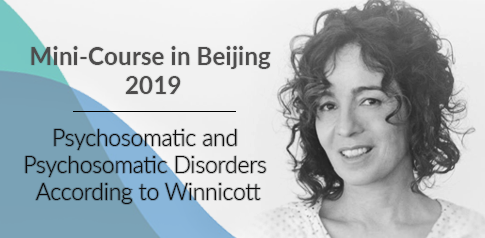Minicourse in Beijing 2019
[vc_row][vc_column][vc_tta_tabs][vc_tta_section title=”Minicourse in Beijing 2019″ tab_id=”1556134441052-476b37e3-cc8a”][vc_column_text]Minicourse in Beijing 2019
Psychosomatic and psychosomatic disorders according to Winnicott
Vera Regina Ferraz de Laurentiis is a Clinical Psychologist, Winnicottian
Psychoanalyst, Professor at Winnicott Institute in São Paulo (Brazil) and at the
International Winnicottian Association. Author of the book Body and Psycho-
somatics in Winnicott and other articles.[/vc_column_text][/vc_tta_section][vc_tta_section title=”First Lecture” tab_id=”1556133972522-19fae34a-44cd”][vc_column_text]First Lecture 01/06/2019 (morning)
I. The history of Winnicott’s research in psychosomatic
A. Formation
B. Winnicott’s work as a pediatrician
C. Exchanges between pediatrics and psychoanalysis
D. Brief examples of psychosomatic disorders in Winnicott’s clinic
II. Broadening the frontiers: the new psychosomatic field
A. Winnicott’s embodied psychoanalysis
B. Soma, psyche, mind and the hyphen
1. I exist, therefore I think
2. Psycho-somatic existence, psycho-somatic partnership and
different types of psychosomatic disorders
C. In the beginning of life, there is no personal body
D. Personalization: the kye to understand the true psychosomatic disorder[/vc_column_text][/vc_tta_section][vc_tta_section title=”Second Lecture” tab_id=”1556133972531-79d23225-fbcb”][vc_column_text]Second lecture 01/06/2019 (afternoon)
I. Personalization: the indwelling of the psyche in the
body
A. The mother’s body ego
B. Loving in a physical way
C. The continuity of the sensory-motor experience
D. The spontaneous gesture and primary creativity
E. The mother/baby’s tasks and the possible ruptures in the
psychosomatic arrangements:
1. Intra-uterine life and birth from the point of view of
psychosomatic arrangements
2. Adjusting to gravity
3. Introducing the baby to his body and the body to the
baby.
4. Adjusting rhythms (breathing, cardiac rhythms,
feeds)
5. The mirror role (When I look I am seen, so I exist)
6. Dealing with the excited states
7. Integrating motility/aggressiveness
8. Some personalization failures in Winnicott’s clinical
fragments.[/vc_column_text][/vc_tta_section][vc_tta_section title=”Third Lecture” tab_id=”1556134002862-5866144c-6583″][vc_column_text]Third Lecture 02/06/2019 (morning)
I. The true psychosomatic disorder and other types of
disturbs in the psyche-soma partnership
A. Conceptualization
B. Winnicott’s clinical examples: anorexia, skin disorders, asthma
etc.
C. Indications for treatment
D. The new clinical issues
1. Countertransference
2. Interdisciplinary approach
3. The psychosomatic integration of the analyst[/vc_column_text][/vc_tta_section][vc_tta_section title=”Gallery” tab_id=”1560367595878-4300001c-8680″][cq_vc_dagallery images=”3238,3240,3241,3242,3243,3244″ thumbtitle=”” thumbdesc=”” color=”#ffffff” background=”#00adb9″][/vc_tta_section][/vc_tta_tabs][/vc_column][/vc_row]

